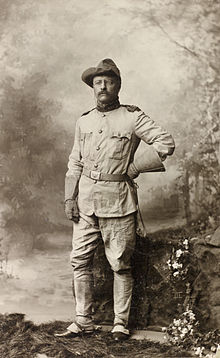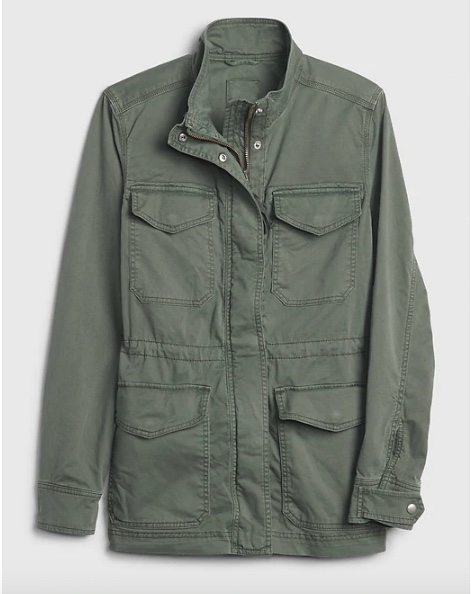Welcome to my new history of fashion series! In this series, I’ll dive into the history of some of our favorite fashion items. I’ll explore where they came from and how they eventually got to where they are now!
This week’s featured piece is the olive green utility/field jacket.
In addition to the moto jacket, this is one of the staple layering pieces in my closet. Not only is it super versatile, but I also really like the edge that it can give to an outfit. Ever since I saw Heroin Bob in SLC Punk rocking an olive green jacket, I knew that I wanted one. I’ve had a version of this jacket in my wardrobe since high school and I feel like I’ll probably have one in my closet till the day I die. I just love it! Now that I’ve expressed my love for this jacket, onto the history!
**I’ve seen that this particular style of jacket is referenced as both a field and utility jacket so, for the purposes of this post, I use them interchangeably.**
The History of the Green Utility Jacket
Civilians have borrowed a lot from the military– Jeeps, peacoats, aviator sunglasses, trench coats, Hummers, combat boots, bomber jackets…and, of course, the olive green field jacket.
Why have we adopted items like these from the military? Is it because they offer function, versatility, and an overall pleasing form? Or is it because, when utilized by us, they can take on a subversive, “don’t-fuck-with-me” vibe?
This jacket was adopted from the U.S. Army, but you probably already knew that. What you may not have known, though, is that the first model for the utility jacket was actually modeled after a civilian windbreaker. Whaaaat?! So, we’re imitating the Army who’s imitating us? Art imitates life imitates art.

The Early Days of the Utility Jacket: the Spanish-American War and WWI
The earliest appearance of the utility jacket seems to come from the uniforms worn by the 1st U.S. Volunteer Calvary, a.k.a. the “Rough Riders“ during the Spanish-American War (April-August 1898). The khaki colored, 2-pocket jacket seen on Colonel Roosevelt was created from a lightweight fabric, possibly linen, that was intended to offset the heat of Cuba.
The belted utility jacket had a button enclosure and a stand collar. While this jacket allowed for some ease of movement, it’s hard to believe it was all that comfortable to wear in the summer in Cuba. Plus, it offered little to no protection from any sort of artillery. A version of this jacket was used throughout WWI, however, the newer version had 4 pockets instead of two and also had a straight collar in place of the stand collar.

The new 4-pocket jacket composed of heavy wool was used throughout WWI (1914-1918). After the end of the war, however, the U.S. military wanted to improve upon the ill-fitting jacket. It proved to be impractical on the battlefield, offering limited mobility and little protection from artillery and the elements.
Around the beginning of WWII (1939-1945) the U.S. Army developed a new jacket to combat (that was punintentional!) the issues they had with the WWI version.
The M-1941
The M-1941, or M-41 for short, was a huge improvement over the WWI field jacket. Not only did it offer a more appropriately fitting bodice, but it was also made of a cotton poplin outer shell and a detachable flannel lining, making it wearable in both the summer and winter. How versatile! It was also advertised as being wind and water resistant and had a zipper front closure with a storm flap. No more buttons for these guys! This jacket served as the primary uniform for soldiers in the army throughout most of WWII.

From left to right: the WWI pocket coat, the M-43, the M-51, and the M-65.
While the M-41 was a great improvement over the WWI field jacket, it still lacked the versatility and fit that soldiers required on the battlefield. What’s more, the M-41 proved to be poorly insulated for the winter months and also ended up not being water resistant! So, a few years later, the new and improved M-43 was unveiled.
The M-1943
The M-43 wasn’t truly worn by soldiers until the very end of WWII and, even then, it’s use was limited as the supplies needed to make it were expensive. This jacket was worn from the end of WWII until the Korean War (1950-1953). It was made of cotton sateen, which was a big improvement upon the cotton and flannel fabrics of the M-41, and reached down to the upper thigh. It had the same 4 large pockets that it had since WWI, but this model was equipped with, wait for it….a detachable hood! The M-43 also reverted back to having button enclosures like the earlier models of the utility jacket.
The M-1951 & the M-1965

Then there was the M-1951 field jacket (are you sick of the letter “M” yet?). This jacket replaced the M-43, however, there wasn’t much that was improved. The only improvements seem to be the addition of a zipper and snaps, instead of buttons and… *drum roll, please!* the olive drab color we all know and love! Yup, it wasn’t until 1951 that the OG-107 dye (the OG stands for Olive Green) was developed and used for U.S. Army uniforms.
As the Vietnam War (1955-1975) rolled around, there was demand for a newer, improved jacket that could withstand the jungles of Vietnam. Thus, the M-1965 was created. The M-65 is the jacket that the trendy modern-day green utility jacket is modeled after.
Instead of having a detachable hood like the M-43 and M-51, the M-65 introduced the packable hood that lived in the back of the collar. The M-65 also had a thin layer of insulation that could be buttoned into the interior during winter months. This version of the utility jacket also had velcro on the sleeves. The M-65 still had the zip-front with snaps and also utilized the storm flap enclosure. As the first American war that was primarily seen in color, the olive green M-65 ended up becoming the symbol of and against the Vietnam War.

While the M-65 was mostly phased out during the mid-1980s, its cultural impact was not lost. Throughout the late 1960s and early 1970s in America, the M-65 was worn as a symbol of resistance against the Vietnam War. Instead of promoting national pride, the utility jacket took on a subversive meaning, mocking the government and the idea of war.
Symbol of the Counterculture?
Because of the strong opposition against Vietnam, wearing the green utility jacket gave the wearer a rebellious edge. It became a visual object of protest.
After Vietnam, the M-65 was used for it’s symbolism in many pop culture movies. The most prominent, of course, is seen in Taxi Driver when worn by Robert DeNiro’s character, Travis Bickle. DeNiro’s character was an honorably discharged U.S. Marine, just returned from Vietnam completely lost and depressed. (Side note: The popularity of the mohawk also came from this movie…oh, and also the “You talkin’ to me?!” speech… man, what an influential movie!)
As I mentioned earlier, the green utility jacket was also featured prominently in SLC Punk. It was worn by Heroin Bob throughout most of the movie, who I’m just now realizing looks a lot like DeNiro’s Travis Bickle…hmmm….
Final Thoughts
Before writing this post, I had no idea just how far back the green utility jacket went into U.S. military history, but I knew that it had been since at least the Vietnam War. Now that I know the whole history of it and just how far back its lineage extends, it does change my attitude toward it a bit.
While I’ve never worn it in patriotic celebration, I’ve also never worn it in protesting condemnation. The fact of the matter is that a jacket like this with such connotations (like any artifact from history) is never truly free from its original intended use. I feel like if you’re choosing to wear an object with such a history behind it, then you should at least be aware of it. There’s always power in knowledge! 🙂
Outfit Details
Show Me Your Outfit!
Tag me on Instagram @amara_andrew with the hashtag #historyoffashion so I can see how you style your green utility jacket!













Leave a Reply